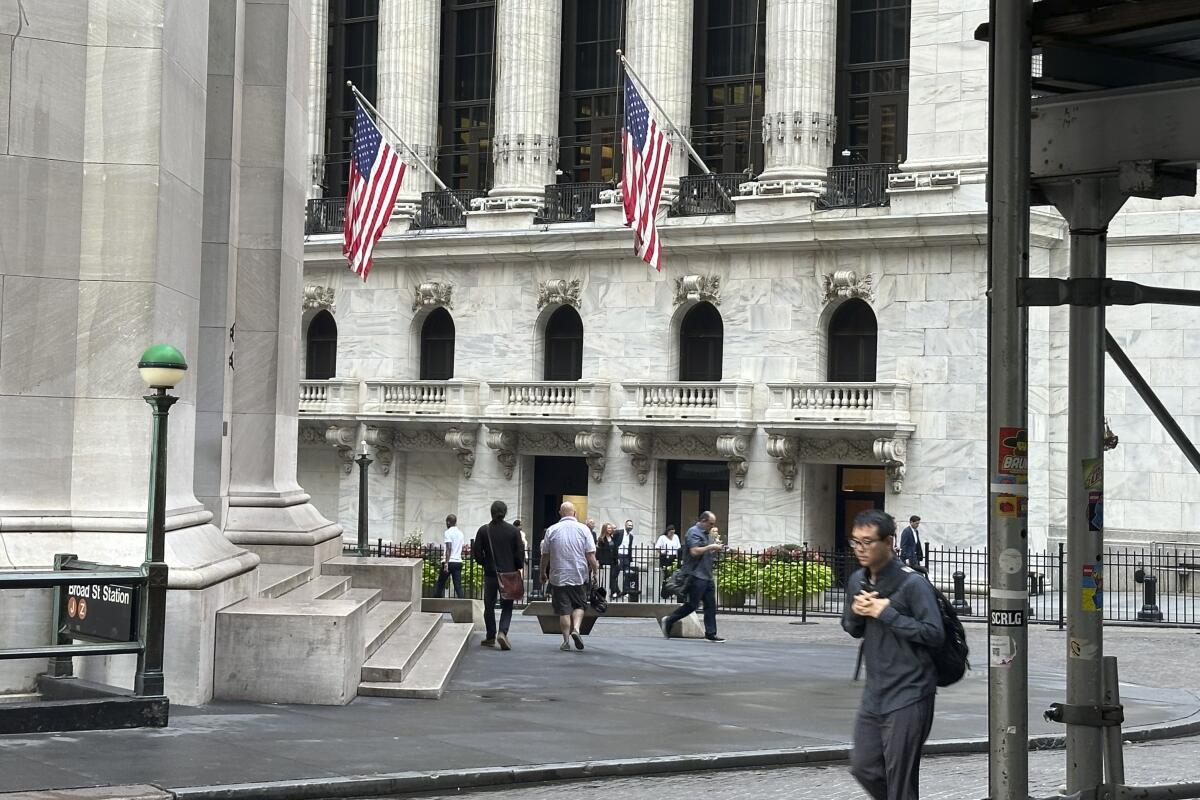Wall Street falls sharply, closing its worst week in nearly 18 months

- Share via
NEW YORK — Another rout hit Wall Street on Friday, with formerly highflying technology stocks again taking the brunt, after a highly anticipated update on the U.S. job market came in weak enough to add to worries about the economy.
The Standard & Poor’s 500 dropped 1.7% to close out its worst week since March 2023. Broadcom, Nvidia and other tech companies led the market lower as worries continue that their prices soared too high in the boom around artificial intelligence, and they dragged the Nasdaq composite down by a market-leading 2.6%.
The Dow Jones industrial average dropped 410 points, or 1%, after erasing a morning gain of 250 points.
Sharp swings also hit the bond market, where Treasury yields tumbled, recovered and then fell again after the jobs report showed U.S. employers hired fewer workers in August than economists expected. It was billed as the most important jobs report of the year, and it showed a second straight month where hiring came in below forecasts. It also followed recent reports showing weakness in manufacturing and some other areas in the economy.
Such a softening of the job market is actually just what the Federal Reserve and its chair, Jerome H. Powell, have been trying to get in order to stifle high inflation, “but only to a certain extent and the data is now testing Chair Powell’s stated limits,” said Scott Wren, senior global market strategist at Wells Fargo Investment Institute.
Friday’s data raised questions about how much the Federal Reserve will cut its main interest rate at its meeting later this month. The Fed is about to turn its focus more toward protecting the job market and preventing a recession after keeping the federal funds rate at a two-decade high for more than a year.
Cuts to interest rates can boost investment prices, but the worry on Wall Street is that the Fed may be moving too late. If a recession does hit, it would undercut corporate profits and erase the benefits from lower rates.
“All is not well with the labor market,” said Brian Jacobsen, chief economist at Annex Wealth Management. “The Fed wanted the labor market to come into better balance, but any balancing act is unstable.”
Still, the jobs report did include some encouraging data. For one, the unemployment rate improved to 4.2% from 4.3% a month earlier. That was better than economists expected. And even if August’s hiring was weaker than forecast, it was still better than July’s pace.
Christopher Waller, a member of the Fed’s board of governors, said in a speech after the jobs report’s release, “I believe we should be data dependent, but not overreact to any data point, including the latest data.”
He added, “While the labor market has clearly cooled, based on the evidence I see, I do not believe the economy is in a recession or necessarily headed for one soon.”
Although Waller said he thinks a “series of reductions” to rates is appropriate given that a slowing job market now looks like the bigger threat for the economy than high inflation, he said the ultimate pace and depth of those cuts is still to be determined.
All the uncertainty sent Treasury yields on a wild ride in the bond market as traders tried to handicap the Fed’s next moves.
The two-year Treasury yield initially fell as low as 3.64% after the release of the jobs report, before quickly climbing back above 3.76%. It then dropped back to 3.66% after Waller’s comments, down from 3.74% late Thursday.
Wells Fargo Investment Institute’s Wren said he was surprised by the size of market swings. Although data have clearly shown a slowdown in the economy, he’s still forecasting growth to continue, “and it’s not the end of the world.” He cautioned investors against panicking and selling their investments in knee-jerk reactions.
Despite its dismal week, the S&P 500 remains just 4.6% below its all-time high set in July. It’s also still up 13.4% for 2024 so far, which counts as a good year.
A big reason for Friday’s sharp drops was weakness for some large tech stocks that had been benefiting from the AI boom.
Broadcom tumbled 10.4% despite reporting profit and revenue for the latest quarter that were above analysts’ forecasts, thanks in part to AI. The chip company said it expects $14 billion in revenue this quarter, which was slightly below analysts’ expectations of $14.11 billion, according to FactSet.
Other chip companies also fell, including a 4.1% drop for Nvidia. After soaring earlier this year as its revenue surged on the AI frenzy, Nvidia’s stock has been shaky since mid-July as investors question whether they took it too high. That’s even though Nvidia has continued to top analysts’ expectations for growth.
“Earnings growth is going to slow from an incredibly high rate to something slower,” Wren said about tech giants, “but it’s not going to be terrible.”
On the winning side of Wall Street was U.S. Steel, which rose 4.3% after the chief executive of rival Cleveland Cliffs told MSNBC that his company would still be interested in acquiring U.S. Steel if the White House were to block its proposed sale to Japan’s Nippon Steel.
All told, the S&P 500 fell 94.99 points to 5,408.42. The Dow dropped 410.34 points to 40,345.41, and the Nasdaq composite slipped 436.83 points to 16,690.83.
In stock markets abroad, indexes fell across much of Europe and Asia. Trading was halted in Hong Kong because of a typhoon.
Choe writes for the Associated Press.
More to Read
Inside the business of entertainment
The Wide Shot brings you news, analysis and insights on everything from streaming wars to production — and what it all means for the future.
You may occasionally receive promotional content from the Los Angeles Times.










